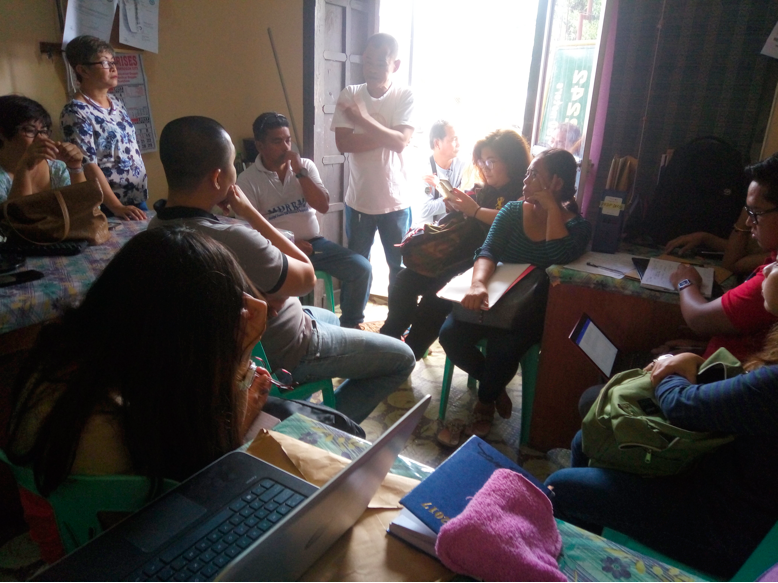 PRDP-Bicol and the PRDP South Luzon Project Support Office conduct the Profiling of Proponent Groups of Proposed I-REAP Subprojects on April 5–6, 2017 to determine the groups’ readiness to take the challenge of optimizing the pili industry in Sorsogon in partnership with DA-PRDP. (Photo by Annielyn L. Baleza, DA-PRDP RPCO V InfoACE Unit)
PRDP-Bicol and the PRDP South Luzon Project Support Office conduct the Profiling of Proponent Groups of Proposed I-REAP Subprojects on April 5–6, 2017 to determine the groups’ readiness to take the challenge of optimizing the pili industry in Sorsogon in partnership with DA-PRDP. (Photo by Annielyn L. Baleza, DA-PRDP RPCO V InfoACE Unit) DA-PRDP partners with co-ops to boost Sorsogon’s pili industry
SORSOGON CITY – They are more than just beneficiaries. They are partners in rural development. This best describes proponent groups in this province that will benefit from the proposed pili trading and processing enterprise subprojects under the enterprise development (I-REAP) component of the Department of Agriculture’s Philippine Rural Development Project (DA-PRDP).
The Sorsogon Pili Producers Cooperative (SPPC) in Irosin, Sorsogon, the Barcelona Development Cooperative (BADECO) in Barcelona, Sorsogon, and the Gubat St. Anthony Cooperative (GSAC) work closely with the PRDP and the Provincial Project Management and Implementation Unit (PPMIU) of Sorsogon with the unified goals of boosting the pili industry and raising the income of pili farmers in the province.
According to Sorsogon PPMIU I-REAP Component Head Esteven Garcia, the province has type 2 climate and volcanic soil, making it suitable for growing pili trees. Reports from the DA High Value Crops Development Program (HVCDP) also show that Bicol is the largest pili producer in the Philippines with about 85 percent share of the country’s pili production.
From 2008 to 2012, Sorsogon has the biggest pili production of 56 percent. Around 2,125 hectares or 60 percent of the province’s agricultural area are planted to pili. However, only 22 percent of pili processors in the province are from Sorsogon, thus pili farmers in the province bring or sell their produce to Albay and Camarines Sur and other provinces for processing.
“It’s about time that our farmers learn how to process our own product. Our objective is to develop our economy first by making use of our own resource, to gather all the pili for the consumption of Sorsogon processors first and foremost. And the surplus, we’ll give to other provinces,” Garcia said.
During the Proponent Group Profiling of Proposed I-REAP Subprojects conducted by PRDP-Bicol and the PRDP South Luzon Project Support Office (PSO) on April 5–6, 2017, the three cooperatives agreed to complement each other. In addition, they agreed to maintain consistent and transparent communication, create uniform quality standards, and pursue similar goals of providing benefits and increasing the income of pili farmers.

PRDP-Bicol and the PRDP South Luzon Project Support Office conduct the Profiling of Proponent Groups of Proposed I-REAP Subprojects on April 5–6, 2017 to determine the groups’ readiness to take the challenge of optimizing the pili industry in Sorsogon in partnership with DA-PRDP. (Photo by Annielyn L. Baleza, DA-PRDP RPCO V InfoACE Unit)
GSAC Business Development Manager Catherine Fidelson considers the partnership of their cooperative with PRDP to be an opportunity to give back to their farmer-members, whom they consider as a vulnerable sector in the Association of Southeast Asian Nations (ASEAN) integration.
The creation of an ASEAN Economic Community composed of 10 ASEAN member-states will form a single market and single production base, a highly competitive economic region that is fully integrated into the global economy with equitable economic development.
“Magandang opportunity ito kasi on the part ng cooperative, nakikita namin na ready ang assistance ng government. We are also willing to invest. In partnership with PRDP, makakatulong kami na maipasa ang proyekto sa intended beneficiaries at makilala ang Sorsogon as source of pili (This is a good opportunity on the part of our cooperative, because we could see that the government is ready to assist, and we are also willing to invest. In partnership with PRDP, we can help in passing down the project to the intended beneficiaries and in promoting Sorsogon as the source of pili),” she said.
PRDP-Bicol I-REAP Component Head Adelina Losa plans to cluster the said proponent groups to develop an I-REAP subproject that will be responsive to the needs of the pili industry in the province. She said that pili has big market prospects and potentials because of its multiple by-products and uses. She also underscored that it would be best if PRDP can partner with farmer-based organizations so that pili farmers would directly benefit from the project.
“Malaki ang chance ng subprojects na ito na ma-increase ang incomes ng pili farmers. Kapag mailing kang farmers na there is really money in pili, dakol ang ma-engage digdi so lalong made-develop ang pili industry ta. As of now, tayo ang major producer of pili, lalo tang mami-maintain ’yan and mapapagayon ta ang quality which iyan ang kaipuhan ta ngunyan lalo pang ino-open ta na ang market sa other countries (These subprojects have big chances of increasing the pili farmers’ incomes. Once pili farmers realize that there is really money in pili, more will engage in pili production which will develop the industry. As of now, Bicol is the major producer of pili. Through these [subprojects] we can maintain that and at the same time, we can improve the quality of our pili products especially now that we have opened the market to other countries),” she added. ### (Annielyn L. Baleza, DA-PRDP RPCO V InfoACE Unit)
